Sreenivasa Rao Cherukuri, Shashi Bhushan V., Harinatha Reddy A., Hymavathy M., Ravindranath D., Aruna M., Swarupa Rani S.
All India Network Project on Pesticide Residues, PJTS Agricultural University, Rajendranagar, Hyderabad, India
Correspondence to: Shashi Bhushan V., All India Network Project on Pesticide Residues, PJTS Agricultural University, Rajendranagar, Hyderabad, India.
| Email: |  |
Copyright © 2015 Scientific & Academic Publishing. All Rights Reserved.
Abstract
Dissipation dynamics of profenofos, triazophos, cypermethrin are studied at doses used by farmers for recommending maximum residue limits (MRL) and pre harvest intervals (PHI) for food safety based on chronic hazard exposure assessment. Profenofos, triazophos, cypermethrin were sprayed twice at the rate of 500, 500 and 50 g.a.i. ha-1, respectively and fruit samples analysed following validated QuEChERS method using gas chromatography with electron capture detector (ECD), thermionic specific detector (TSD) and mass spectra detector (MS/MS with triple quadrupole). Fruit samples are detected with deposits of 1.698 mg kg-1 profenofos, 1.108 mg kg-1 triazophos, and 0.158 mg kg-1 cypermethrin dissipated to Below Determination Level (BDL) by 10th, 7th and 5th day, respectively. MRL of 4 mg kg-1 for profenofos, 3 mg kg-1 for triazophos and 0.4 mg kg-1 for cypermethrin is recommended based on chronic hazard exposure assessment parameters (theoretical maximum daily intake), and PHI of 1 day is recommended for food safety taking into consideration of MRLs of Codex and MRLs calculated from present investigation.
Keywords:
Tomato, Insecticide Residues, Risk Analysis, Food Safety
Cite this paper: Sreenivasa Rao Cherukuri, Shashi Bhushan V., Harinatha Reddy A., Hymavathy M., Ravindranath D., Aruna M., Swarupa Rani S., Dissipation Dynamics and Risk Assessment of Profenofos, Triazophos and Cypermethrin Residues on Tomato for Food Safety, International Journal of Agriculture and Forestry, Vol. 5 No. 1, 2015, pp. 60-67. doi: 10.5923/j.ijaf.20150501.09.
1. Introduction
Tomato (Lycopersicon esculentum Mill.) is widely consumed vegetable in India in the form of curry, and also in raw form as salad, home-cooked, or processed as juice, paste, or sauce. During 2012-13 in India, tomato was cultivated in an area of 879.6 thousand ha with an average annual production of 18226.6 thousand t and productivity of 20.7 t ha-1, which contributed about 9.6% of total vegetable area and 11.2% of total vegetable production [1]. The tomato yield is affected due to damage caused by leaf hoppers, aphids, caterpillar, flea beetles, leaf miner, spider mites, and fruit borer [2] and use of synthetic pesticides are very common practice to manage the pest to below threshold levels, but on many occasions, non-judicious use of pesticides lead to imbalance in biotic factors, and also and food safety concerns due to residue contamination in foods. Profenofos, organo thiophosphorous insecticide and acaricide, is the most commonly used against both sap sucking and chewing insects and mites due to its systemic, contact and acaricidal action, is available in India in 50% EC. Triazophos, hetero cyclic organo thio-phosphorousinsecticide, acaricide and nematicide, registered in India as 40% EC. Cypermethrin, synthetic pyrethroid insecticide and acaricide, commonly used against chewing insects and red spider mites, available in India in 10% EC. As per Insecticide Act, 1968 of India [3] profenofos, triazophos and cypermethrin are not registered for use on tomato. Further, the reports on national residue monitoring studies and state level monitoring studies conducted by the laboratory revealed that profenofos, triazophos and cypermethrin residues are detected in samples collected from markets, and based on the survey conducted to know the farmer’s practice, it is documented that farmers use profenofos 50% EC, triazophos 40% EC and cypermethrin 10% EC at the rates of 500 g.a.i. ha-1, 500 g.a.i. ha-1, 50 g.a.i.ha-1, respectively, for the control of insects and mites, hence profenofos, triazophos and cypermethrin residues were detected in samples collected from markets. Based on the reports of non-registered or non-recommended pesticide residues reported on tomato, Department of Agriculture and Cooperation, Government of India, initiated GAP (Good Agricultural Practices) trials to estimate the dissipation / residues of these pesticides on tomato for recommending MRLs (Maximum Residue Limits) taking into consideration of risk analysis performed with ADI (Acceptable Daily Intake), food factor and average body weight. The ADI for profenofos is of 0-0.03 mg. kg-1 body weight (bw), triazophos is 0.001 mg. kg-1 bw and for cypermethrin is 0.02 mg. kg-1 bw as per Codex Alimentarius Commission (CAC). To estimate the risk due to pesticide residues present in/on tomato, food consumption data is very mandatory. As per the National Sample Survey conducted during 2011-12 in India, per capita consumption of tomato in rural and urban area is 586 and 806 grams per month, respectively [4]. Tomato contains 200 kcal kg-1, 9 g protein kg-1, and 2 g fat kg-1 [5]. Maximum Residue Limits (MRL) for profenofos, triazophos and cypermethrin on tomato are not set by Government of India [6]. Hence analysis on presence of residues at harvest time following farmers practice is essential to study the risk analysis. A study was conducted during 2012-13 crop seasons to analyze dissipation pattern of profenofos, triazophos and cypermethrin on tomato so as to recommend MRLs, pre harvest intervals based on the risk analysis.
2. Materials and Methods
2.1. Chemicals and Reagents
Certified Reference Materials (CRM) of profenofos (96.9% purity), triazophos (95.4% purity) and cypermethrin (94.3% purity) were procured from M/S Sigma Aldrich, Germany, and primary, intermediary and working standards were prepared from the CRMs using GC PR grade acetone and hexane as solvents. Working standards of all the pesticides were prepared in the range of 0.01 ppm to 0.5 ppm in 10 mL calibrated graduated volumetric flask using distilled n-hexane as solvent. For sample preparation Primary Secondary Amine (Agilent), magnesium sulfate anhydrous (Emsure grade of Merck), sodium sulfate anhydrous (Emparta ACS grade of Merck), acetonitrile (HPLC gradient grade of Merck), acetic acid glacial (HPLC grade of Merck), acetone (Emplure grade of Merck), n-hexane (HPLC grade of Merck) were used during the study. Profenofos 50% EC, Triazophos 40% EC and Cypermethrin 10% EC were procured from local market.
2.2. Analytical Instruments and Limits of Detection
Working standards are injected in Gas Chromatograph (Agilent 7890 B) with Electron Capture Detector (ECD) and Thermionic Specific Detector (TSD) with injector split ratio of 1:10 using VF-5ms Capillary Column) (Fig 1) and confirmatory analysis was done on Bruker Scion 436 GC-MS/MS Triple Quadrupole Detector (EI) (Fig 2) using Multiple Reaction Monitoring (MRM) method as given in Table 1. It was found that the limit of detection for profenofos, triazophos is 0.05 ng in GC-TSD, 0.05 ng for cypermethrin on GC-ECD and the linearity is in the range of 0.05 ng to 5 ng. The standard chromatograms of profenofos, triazophos and cypermethrin are presented in Fig 3-5. | Figure 1. Gas Chromatography with Electron Capture and Thermionic Specific Detector |
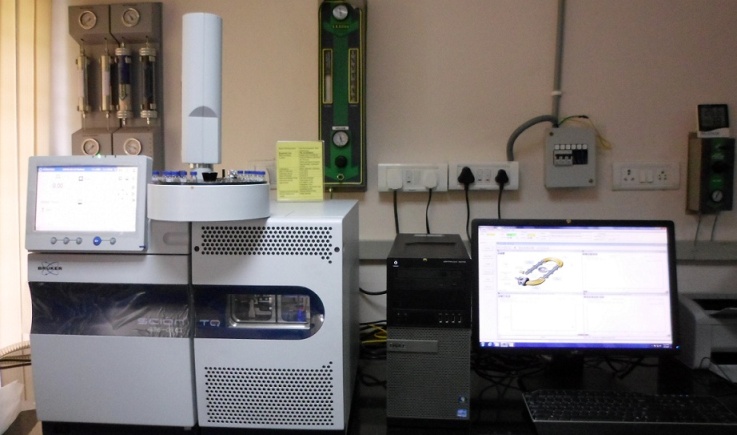 | Figure 2. Gas Chromatography with tandem triple quadrupole mass spectra detector |
Table 1. MRM (Multiple Reaction Monitoring) method parameters for qualitative and quantitative analysis of profenofos, triazophos and cypermethrin in tomato on GC-MS/MS (TQD)
 |
| |
|
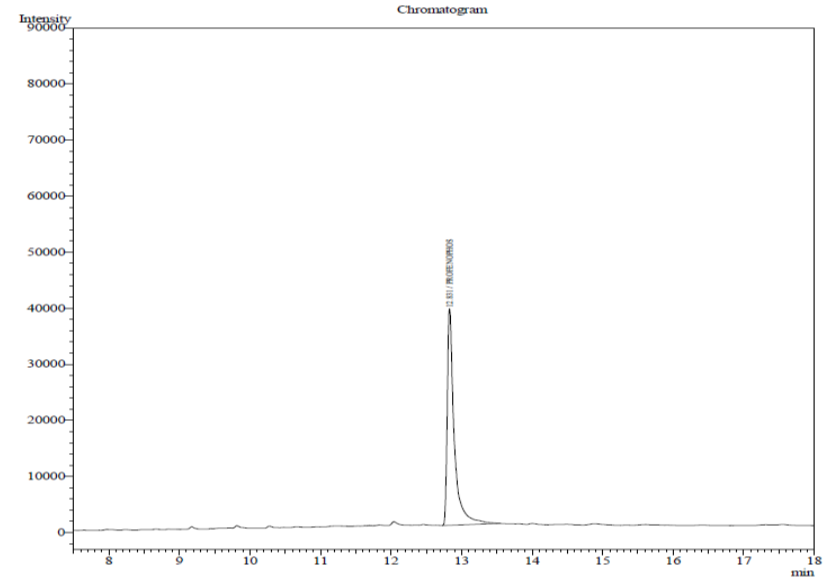 | Figure 3. Standard chromatogram of profenofos on GC-ECD at 0.5 ppm |
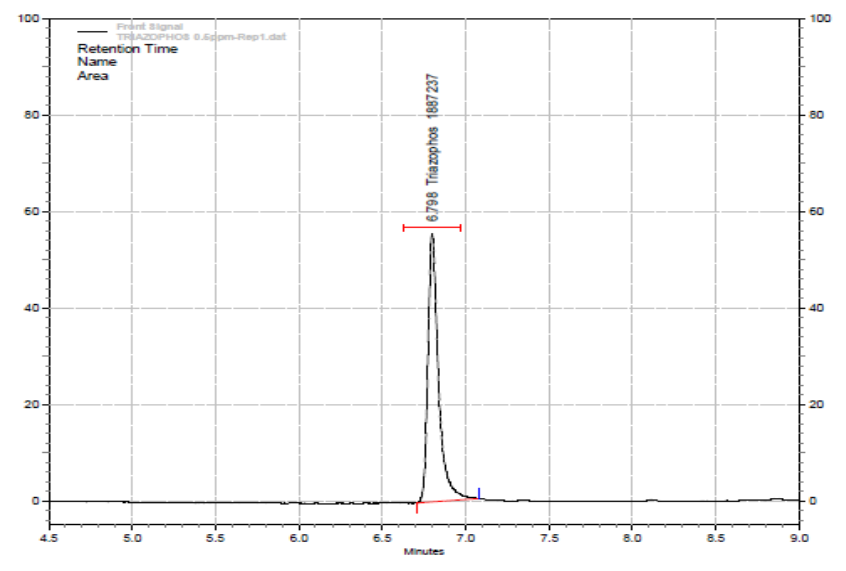 | Figure 4. Standard chromatogram of triazophos on GC-TSD at 0.5 ppm |
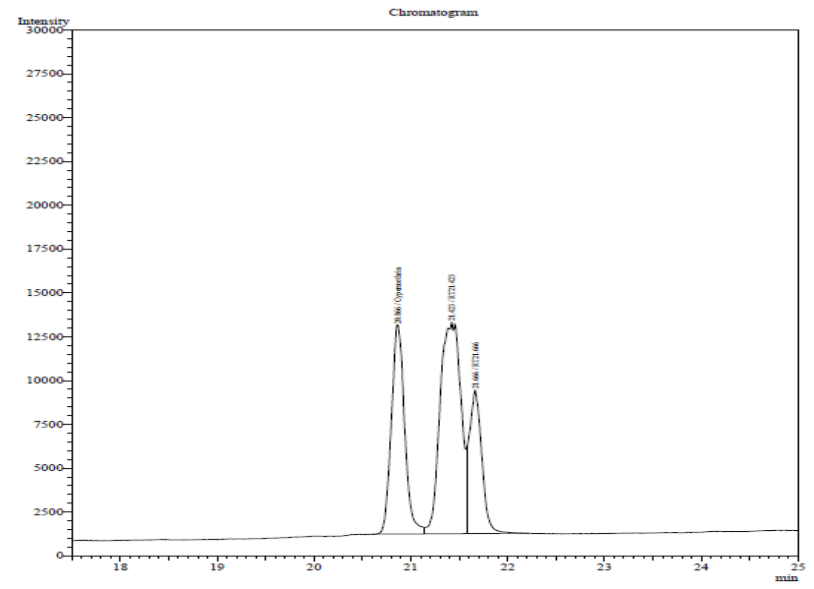 | Figure 5. Standard chromatogram of cypermethrin on GC-ECD at 0.5 ppm |
2.3. Method Validation
Prior to field experiments, QuEChERS (Quick Easy Cheap Effective Rugged Safe) method [7] for extraction and clean up was validated as per SANCO/12495/2011 guidelines [8]. Tomato fruits (5 kg) collected from control plots were homogenized with high volume homogenizer (Robot Coupe Blixer 7L) and 15 g was taken in to 50 mL centrifuge tubes. The required quantity of profenofos, triazophos and cypermethrin intermediary standards are added to each 15 g sample to get fortification levels of 0.05 mg kg-1, 0.25 mg kg-1 and 0.5 mg kg-1 in three replications each. 30±0.1 mL acetonitrile was added to the tube, and sample was homogenized for 2-3 min using Heidolph silent crusher (low volume homogeniser). Then 3±0.1g sodium chloride was added to tube and mixed by shaking gently, and centrifuged for 3 min at 2500-3000 xg with Remi R-238 to separate the organic layer. The top organic layer of about 16 mL was taken into the 50 mL centrifuge tube to which 9±0.1 g anhydrous sodium sulphate was added to remove the moisture content. 8 mL of extract was taken in to 15 mL tube containing 0.4±0.01g PSA sorbent (for dispersive solid phase d-SPE cleanup) and 1.2±0.01 g anhydrous magnesium sulphate, and the sample tube was vortexed for 30 sec followed by centrifugation for 5 min at 2500-3000 xg. The extract of (2mL) was transferred into test tubes and evaporated to dryness using concentration work station (Turbovap LV of Caliper life sciences) with nitrogen gas and reconstituted with 1mL n-Hexane: Acetone (9:1) for dimethoate analysis. Tomato samples fortified with profenofos, triazophos and cypermethrin at 0.05 mg kg-1, 0.25 mg kg-1 and 0.5 mg kg-1 were analyzed and the mean recovery of the residues calculated for applying recovery factor while calculating the residues in samples. Fortification and recovery test results were presented in Table 2 and the method followed for qualitative and quantitative estimation of profenofos, triazophos and cypermethrin is suitable up to 0.05 mg kg-1 levels as the recoveries obtained are 92.67%, 93.33% and 88%, respectively at 0.05 mg kg-1 fortification level. The residues detected below 0.05 mg kg-1 were mentioned as levels Below Determination Level (BDL) in all cases.Table 2. Fortification and recovery results for method validation
 |
| |
|
2.4. Field Experiments
Tomato crop (Popular hybrid Super Sujan) was grown in open field laid out in Randomized Block Design at spacing of 60×45 cm with each plot size of 20 m2 and critical Good Agricultural Practices (GAPs) recommended by University were followed such as field preparation, seed rates (150-200 g ha-1), fertilizer applications (350 kg ha-1 super phosphate and 100 kg ha-1 murate of potash at the time of transplantation; equal split application of 140 kg ha-1 nitrogen at 30, 45 and 60 days after transplanting (DAT); spray of zinc sulfate at the rate of 5 g.L-1 at 30 and 45 DAT) and irrigations at regular weekly intervals. Profenophos, triazophos and cypermethrin were sprayed at the rates of 500 g. a.i. ha-1, 500 g. a.i. ha-1, and 50 g a.i. ha-1, respectively twice; first spray at fruit initiation stage followed by second spray at 10 days after first spray, using high volume knapsack sprayer with a spray solution of 500 L ha-1.
2.5. Calculation Methods
Tomato fruit samples were collected at regular intervals i.e. 0, 1, 3, 5, 7, 10, 15, 20 days after last spray for dissipation studies. Qualitative and Quantitative analysis of residues of profenophos, triazophos and cypermethrin were done following validated methods explained in 2.3 using the analytical instruments given in 2.2. Half-life and TBDL (Time required for residues to reach below determination level) were calculated as per Hoskins [9] from first-order dissipation kinetics. OECD (Organization for Economic Co-operation and Development) MRL calculator is used for calculation of MRL and chronic hazard risk analysis was performed using TMDI (Theoretical Maximum Daily Intake) for arriving at MRL for recommendation.
3. Results and Discussions
3.1. Dissipation and Risk Analysis for Profenofos
Dissipation studies conducted for profenofos on tomato indicate (Table 3) that initial residues of 1.698 mg kg-1 dissipate to 0.879 mg kg-1 in 24 hours, 0.401 mg kg-1 by 3rd day, 0.184 mg kg-1 by 5th day, 0.068 mg kg-1 by 7th day, and BDL (0.05 mg kg-1) by 10th day. The calculated half-life is 1.57 days, and TBDL is 12.08 days. Gupta, et al [10] reported that residues of profenofos dissipated with half-life of 2.2-5.4 days, and Sahoo, et al [11] reported that profenophos spray on tomato at 500 g. a.i. ha-1 first at 50% flowering stage and subsequently at 15 days intervals, resulted in to initial deposit of 1.37 mg kg-1 dissipating to BDL in 15 days, and similar results also reported by Ahmad, et al [12] on tomato. Experimental results of Radwan, et al [13] shows that at application of very high dose i.e. 1280 g. a.i. ha-1 on three crops viz., green pepper, hot pepper and brinjal results in very high initial deposit of 10-11 mg kg-1 on pepper, and 4.50 mg kg-1 on brinjal, which dissipated to BDL in 2 weeks. However, the studies conducted by various workers [10, 14-15] on dissipation on profenophos on different crops clearly indicate that when applied at recommended dose, the initial deposits are less than 3 mg kg-1 and dissipate to BDL in 7-10 days depending on the crop, except on cardamom. Based on the OECD calculator, proposed MRL is 4 mg kg-1, and hazard exposure assessment conducted taking into consideration of national averages of body weights, per capita tomato consumption, ADI, risk analysis indicator i.e. TMDI calculated in 0.00196 which is less than ADI values, and hence MRL of 4 mg kg-1 is recommended based on farmers practice. Pre-harvest interval of 1 day is proposed taking in to consideration of MRLs of CAC, EU and present experiment results (Table 4). Various workers suggested safe waiting periods varying from 1 to 14 days, but as per CCPR guidelines based on CAC and EU MRLs (10 mg kg-1) it is not necessary to recommend waiting periods till the residues reach BDL. Taking into consideration of MRLs set by CAC, EU and calculated MRLs based on present study, it can be scientifically concluded and recommended that PHI of 1 day as the initial deposits are below 10 mg kg-1.
3.2. Dissipation and Risk Analysis for Triazophos
Initial deposits of 1.108 mg kg-1 triazophos (Table 3) were detected in tomato samples collected from plots sprayed with triazophos 40% EC when applied at 500 g ai ha-1, which dissipated to 0.666 mg kg-1 by 1st day. The triazophos residues were below detectable level of 0.05 mg kg-1 in 7 days, with a calculated half-life of 1.14 days, and 9.49 days to come to BDL. Statistical formulae applied as per OECD procedure, and the suggested MRL is 3 mg kg-1, and based on the proposed MRL, TMDI is more than ADI, and hence PHI of 1 day is recommended to avoid the risk of triazophos residues for food safety (Table 4). MRLs are not set legally both by CAC and FSSAI, but EU fixed MRL of 0.01 mg kg-1 on tomato. The EU MRL is very low i.e. limit of detection, as triazophos is not recommended for use in EU. The risk analysis conducted based on the highest estimate of 3.0 mg kg-1 obtained in the present studies conducted taking into consideration of farmers practice, indicate that highest estimate of 3 mg kg-1 can cause risk where TMDI>ADI, but however, during the present study initial deposits of 1.108 mg kg-1 is recorded. The risk analysis based on actual initial deposits clearly concludes that farmers practice is safe as these levels do not pose any risk. Hence, MRL of 3 mg kg-1 can be recommended in India on Tomato.Table 3. Dissipation dynamics of profenofos, triazophos and cypermethrin on tomato
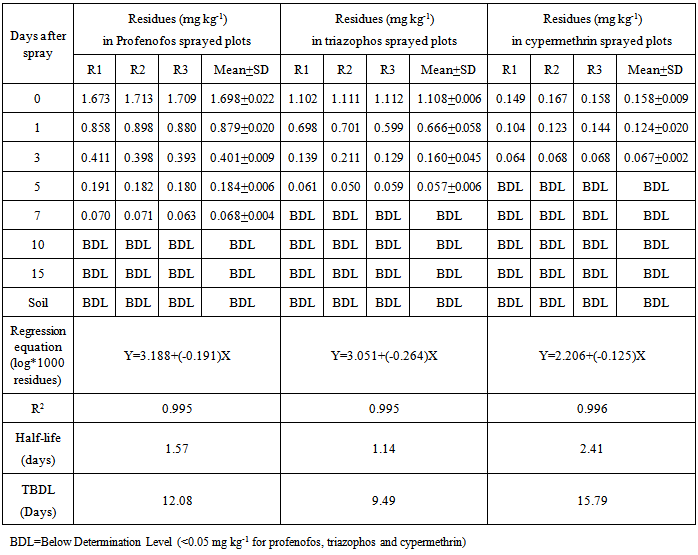 |
| |
|
Table 4. Chronic Hazard Exposure Assessment for recommending MRL and PHI for profenofos, triazophos and cypermethrin on tomato
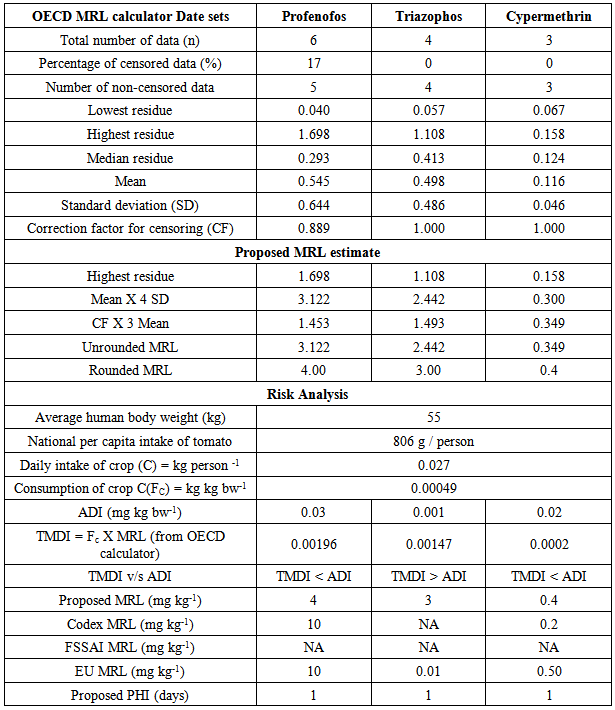 |
| |
|
3.3. Dissipation and Risk Analysis for Cypermethrin
Spray of cypermethrin 10% EC twice at the rate of 50 g.a.i. ha-1 as per the farmers practice, resulted an initial deposits of 0.158 mg kg-1 which dissipated to BDL of 0.05 mg kg-1 by 5th day after spray (Table 3). The half-life is 2.41 days, and calculated TBDL is 15.79 days. Gupta, et al [10] reported that residues of cypermethrin on fruits dissipated with half-life of 2-3.6 days. The studies conducted by Nilufar Nahar, et al [16] recorded 0.55 mg kg-1 initial residues of cypermethrin on tomato when sprayed at recommended dose. Based on the dissipation dynamics of cypermethrin on tomato, MRL of 0.4 mg kg-1 is calculated as per OECD MRL calculator (Table 4). The ADI of cypermethrin is 0.02 mg kg-1 as per CAC, and the taking into consideration of national data, the calculated TMDI is less than ADI, and hence cypermethrin spray on tomato can be allowed provided the data requirements for registration is satisfied. Based on the farmers practice, and the MRLs of CAC, EU and MRL calculated from present studies, PHI of 1 day can be recommended for food safety. In India, MRLs for cypermethrin on tomato are not fixed as per FSSAI (Food Safety and Standards Authority of India), since the pesticide is not registered for use on tomato as per Insecticide Act.
4. Conclusions
As per the Insecticide Act, profenofos, triazophos and cypermethrin are not registered for use on tomato, and also MRLs are not fixed as per FSSAI. The present study conducted based on the results of national monitoring data base and also farmers practice (profenofos 50% EC, triazophos 40% EC and cypermethrin 10% EC at the rates of 500, 500 and 50 g ai ha-1, respectively, twice; first at fruit initiation followed by 10 days interval), to assess the dissipation pattern for recommending MRLs and PHIs through risk analysis. MRL of 4 mg kg-1 for profenofos, 3 mg kg-1 for triazophos and 0.4 mg kg-1 for cypermethrin is recommended based on OECD MRL calculator and chronic hazard exposure assessment parameters, and PHI of 1 day is recommended taking into consideration of MRLs of CAC and MRLs calculated from present investigation. Based on the existing MRLs of EU (European Union), it can be concluded that the initial deposits i.e. highest residues of profenofos and cypermethrin are safe, and in case of triazophos, though the TMDI>ADI when highest calculated residues is taken, but however, the highest initial deposits of triazophos are 1.108 mg kg-1 which is safe based on the risk analysis.
References
| [1] | Indian horticulture database 2014. National Horticultural Board. February 2014. Pp.181-185. |
| [2] | Singh, B., Singh, P.P., Battu, R.S. and Kalra, R.L. 1989. Residues of synthetic pyrethroid insecticides on tomato under sub-tropical conditions of Punjab, India. Bull. Environ. Contam. Toxicol. 43 (5), 733–736. |
| [3] | Major uses of Pesticides (Registered under the Insecticides Act, 1968) 2012 at http://cibrc.nic.in/ mup. htm. Accessed on 27 July 2012. |
| [4] | Anonymous. 2014. Household consumption of various goods and services in India 2011-12. Ministry of Statistics and Programme Implementation, Government of India. Pp 1-1143. |
| [5] | Gopalan, C., Ramasastry, B.V. and Balasubramanian, S.C. 1989. Nutritive Values of Indian Foods (NVIF); National Institute of Nutrition, Hyderabad, India. 156pp. |
| [6] | Food Safety and Standards (Contaminants, Toxins and Residues) Regulation (2011) available athttp://www.fssai.gov.in/Portals/0/Pdf/Food%20safety%20 and%20 standards% 20%28 contaminats,%20toxins%20and%20residues%29%20 regulation,% 202011.pdf. Accessed on 27 July 2012 and 6 December 2014. |
| [7] | Anastassiades, M., Lehotay, S.J., Stajnbaher, D. and Schenck, F.J. 2003. Fast and easy multiresidue method employing acetonitrile extraction/partitioning and "dispersive solid-phase extraction" for the determination of pesticide residues in produce. J. AOAC Int. 86(2), 412-431. |
| [8] | SANCO/12495/2011. Method validation and quality control procedures for pesticide residues analysis in food and feed. European Commission Health and Consumer Protection Directorate-General. |
| [9] | Hoskins, W.M. 1966. Mathematical treatment of the rate of loss of pesticide residues. FAO Plant Prot. Bull. 9: 163-168. |
| [10] | Gupta, S., Gaibhiye, V.T., Sharma, R.K. and Ram, K. 2011. Dissipation of cypermethrin, chlorpyriphos, and profenofos in tomato fruits and soil following application of pre mix formulations. Environ. Monit. Assess. 174 (1-4): 337-345. |
| [11] | Sahoo, S.K., Kapoor, S.K. and Singh, B. 2004. Estimation of residues of profenophos in/on tomato, Lycopersicum esculentum Mill. Bull. Envi. Cont. Toxicol. 72: 970-974. |
| [12] | Ahmed, A.R., Tarek, M.M., Rady, A.R. and Mohamed, Y.H. 2009. Dissipation of Profenofos, Imidacloprid and Penconazole in Tomato Fruits and Products. Bull. Envi. Cont. Toxicol. 83:812–817. |
| [13] | Radwan, M.A., Shiboob, M.M., Elamayem, A. and Aal, A.A. 2004. Pirimiphos-methyl residues in some field grown vegetables and removal using various washing solutions and kitchen processing. Int. J. Agri. and boil. 6(6):1026-1029. |
| [14] | Katroju, R., Cherukuri, S.R., Vemuri, S.B. and Reddy, N.K. 2014. Dissipation pattern of profenophos in tomato. Int. J. of App. Bio. and Pharma. Tech. 5(1): 252-256. |
| [15] | Renuka, S., Rajabaskar, D and Regupathy, A. 2006. Persistence and dissipation of profenofos 50 EC in cardamom. Ind. J. of Pl. Prot. 34(2): 165-167. |
| [16] | Nilufar Nahar., Mohammad, S.M., Iqbal, R.M., Sultan, A., Mir, M.H. and Ahmedul, K. 2012. Studies of dissipation pattern of cypermethrin in tomato. J. Bangladesh Chem. Soc. 25(2): 200-203. |






 Abstract
Abstract Reference
Reference Full-Text PDF
Full-Text PDF Full-text HTML
Full-text HTML


